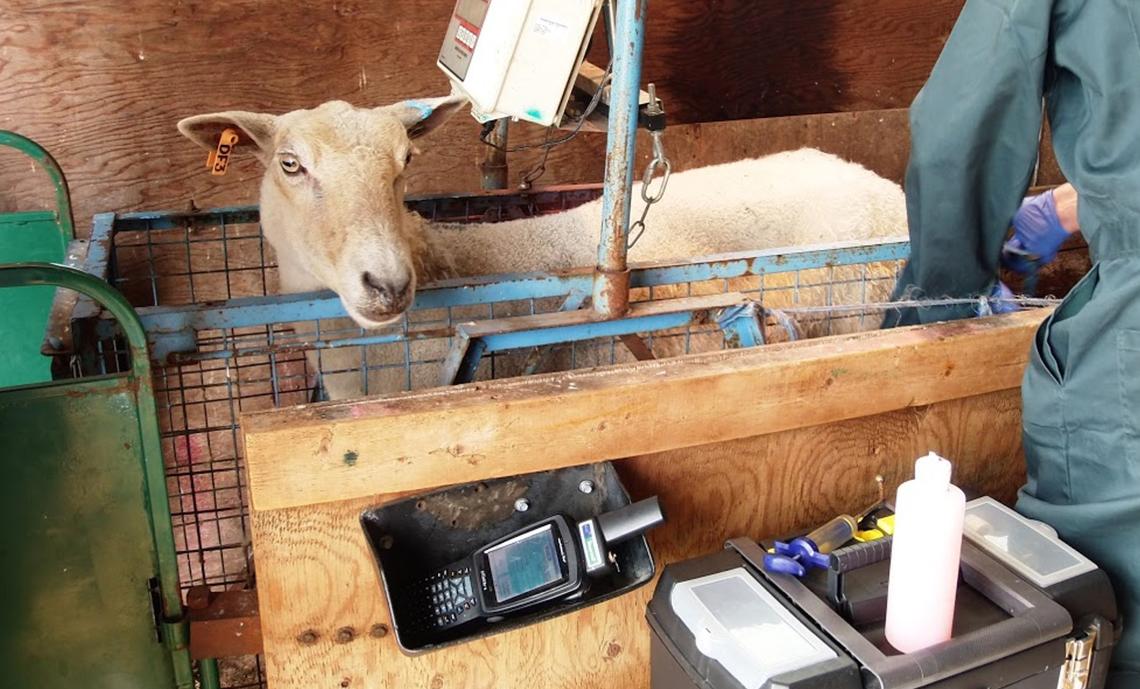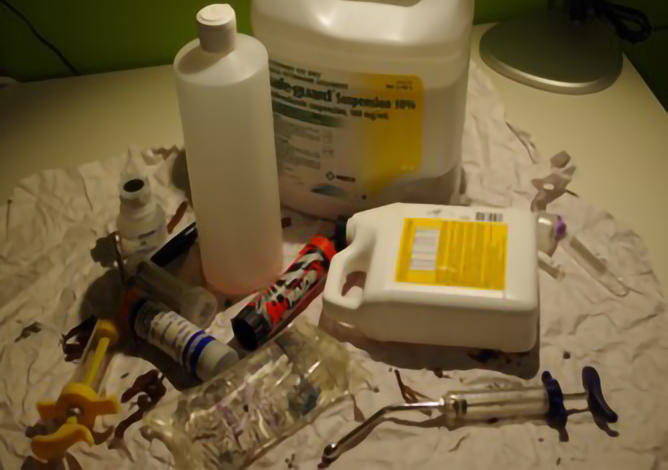Dewormer
What dewormer should I use and how to use it successfully?
The best dewormer for your flock depends on the parasite burden, the species of parasites, the stage of production (ewe vs. lamb vs. ram) and the possible resistance of the parasites. The following is for informational purposes only; it is important that you consult your veterinarian for information specific to your flock and needs.
Not all dewormers are the same
Dewormers are classified into different groups based on the type of molecule. Each class kills or expels worms in a different way. For example, Safe-Guard® (fenbendazole) and Valbazen® (albendazole) are in the benzimidazole class. They kill parasites by disrupting the digestive system of the worm. Ivomec® (ivermectin) and Cydectin® (moxidectin) are in the macrocyclic lactone class. They act by paralyzing the worms.
When parasites become resistant to one drug within a class, they are often resistant to all drugs in the same class, for instance if the parasites are resistant to Safe-guard, they will be resistant to Valbazen and vice versa. This is important when considering using a combination of drugs, as the combination should include dewormers from different classes. Make sure you check with your veterinarian.

Picture 1. Administering a dewormer with a syringe
Dewormers commonly used in Canada, dosages and withdrawal times
The following 2 tables summarize the different dewormers, dosages and withdrawal times that are recommended for sheep.
Consult with your veterinarians for dosage and withdrawal times for goats. Startect should not be used in goats.
Table 1: Summary of dewormers commonly used in Canada (information as of Nov 2021)
|
Drug |
Active compound |
Class |
Effective against |
Resistance in western Canada? |
Licensed for use in Canada? |
|---|---|---|---|---|---|
|
Ivomec, Noromectin |
Ivermectin |
Macrocyclic lactones |
All gastrointestinal nematodes and against external parasites such as sucking lice and nose bots |
Yes |
Yes |
|
Flukiver |
Closantel |
Salicylanilide |
Blood feeding parasites. Often combined with a dewormer from another class |
Not reported |
Yes as of 2016 |
|
Startect |
Abamectin & Derquantel |
Macrocyclic lactones |
All gastrointestinal nematodes |
Not reported |
Yes as of 2018 |
|
Safe-guard |
Fenbendazole |
Benzimidazole |
All gastrointestinal nematodes |
Yes |
No |
|
Valbazen |
Albendazole |
Benzimidazole |
All gastrointestinal nematodes. May also kill liver flukes |
Yes |
No |
|
Prohibit |
Levamisole |
Imidazothiazole |
All gastrointestinal nematodes |
Yes, but limited |
No |
|
Cydectin |
Moxidectin |
Macrocyclic lactone |
All gastrointestinal nematodes |
Not reported |
No |
Table 2. Dose and withdrawal time of dewormers commonly used in Canada (information as of Nov 2021)
Doses are in mg/kg, volumes are in ml of the product/weight in lbs
|
Drug |
Active compound |
Dose (always check label) |
Withdrawal time (always check label) |
Licensed for use in Canada? |
|---|---|---|---|---|
|
Ivomec, Noromectin |
Ivermectin |
Drench |
14 days after last treatment 35 days after last treatment |
Yes |
|
Flukiver |
Closantel |
Drench |
49 days after last treatment |
Yes as of 2017 |
|
Startect |
Abamectin & Derquantel |
Drench 1ml/11 lb. |
14 days after last treatment |
Yes as of 20178 |
|
SafeGuard |
Fenbendazole 10% |
Drench |
Not established in Canada |
No |
|
Valbazen |
Albendazole 11.36% solution |
Drench |
Not established in Canada |
No |
|
Prohibit |
Levamisole |
Check label |
Not established in Canada |
No |
|
Cydectin |
Moxidectin |
Drench: |
Not established in Canada |
No |
Successful deworming and what to check if treatment fails
Choosing the correct dewormer
Not all dewormers target the same parasites. For example, Flukiver® is useful for the treatment of sheep with a high burden of Haemonchus contortus (the barber’s pole worm). However, it is not effective against the worms that cause parasitic gastroenteritis such as Teladorsagia circumcincta (the brown stomach worm). In addition, some parasites are resistant to the dewormer so it is important to not assume that one dewormer will work on all parasites.
Pour-on dewormers are not very effective in sheep. Do not use injectable products as drenches.
Be sure to consult with your veterinarian to select a dewormer that best addresses the situation on your farm.
Following all label dose recommendations and/or your veterinarian instructions
It is important to follow the instructions printed on the label of the dewormer where dosage is calculated by the weight of the animal. It is best to use a calibrated livestock scale to accurately measure the weight of individual animals and dose accordingly. Using a dose based on estimated weight of the average ewe and adding a little more for the heavier animal and a little less for the lighter ewe can often lead to under-dosing of some animals. If a scale is not available, estimating the weight of the heaviest ewe and using this dose for the other ewes will prevent under-dosing. This is safe for most dewormers, but you should consult your veterinarian on the best strategies for accurate dosing for the drug you are choosing to use and in your particular situation.
If at any time a few drops fall out of the sheep’s mouth be sure to give a little more dewormer so that you are not under-dosing.

Picture 2. Use a scale to dose according to weight

Picture 3. Use the correct syringe to deliver the drench
Using correct equipment
When deworming your animals with a drench, be sure to use the correct equipment. A purpose-built drenching syringe or drench gun is the best and most accurate tool to use for delivering a drench. Drenching syringes/guns are made to slide over the back of the sheep’s tongue and deliver the dewormer near the back of the animal’s throat. Always check the syringe/gun is delivering the right amount before you drench. Syringes used for subcutaneous or intramuscular injections are not designed for drenching and can lead to inaccurate dosing.
Following the label storage instructions
Failure to do so may result in degradation of the drug and decreased deworming effectiveness over time. For example, for best results, Flukiver® must be stored at temperatures below 30°C, should be protected from light exposure and should be discarded after 3 months following opening.
Pasture management to prevent reinfection
Dewormers, provided they are working properly, kill the parasites inside the animal. However, most dewormers are only short acting and do not provide ongoing protection from re-infection. So, if sheep remain on pastures that are heavily contaminated with infective L3 larvae after they have been dewormed, they will continue to ingest larvae, which take just 2-3 weeks to develop into adult worms. Consequently, if animals continue to be in poor condition or have clinical signs several weeks after dewormer administration it may be due to re-infection. In these circumstances, it is important to move sheep on to less contaminated pastures.
If all the issues above are monitored, it may be that the parasite is resistant to the dewormer used. Anthelminthic resistance occurs when gastrointestinal roundworms undergo genetic changes that allow them to survive exposure to dewormers. This is now a major problem in western Canada and is discussed in more detail in the next section.
For more information go to the Sustainable Control of parasites (SCOPS) website.

Picture 4. Make sure the dewormer is correctly stored and not past the expiration date
